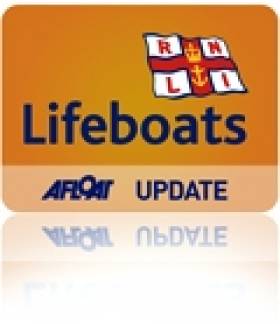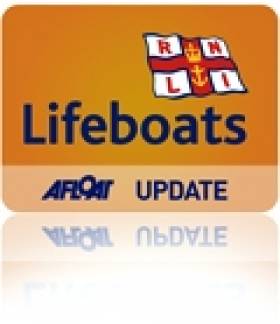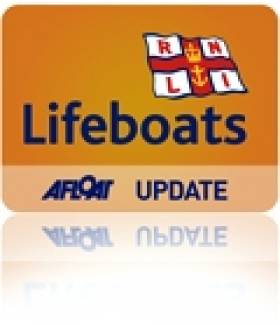Displaying items by tag: Lifeboat
Tennis Duo's Untold Titanic Story
#TITANIC - The Irish Times has highlighted "one of the less well-known tales of the disaster" of the Titanic, regarding two tennis champions who went on to enter that sport's hall of fame.
The story of Richard Williams and Lark Behr was told at an exhibition of sporting memorabilia in Yorkshire last month by collector Robert Fuller.
Williams, who was 21 at the time, was headed to the US Championships when the Titanic went down. He was among those rescued by the Carpathia after hours in frozen water, and fought with that ship's doctor who wanted to amputate his legs.
His persistence paid off, as just months later he was in the quarter finals of the US Open, a context he would win in 1914 and 1916, not to mention the Wimbledon doubles title in 1920 and Olympic gold in the mixed doubles in 1924.
Behr - who reportedly proposed to his fiancée on a lifeboat - also had a glittering career after the tragedy, reaching the doubles final at Wimbledon and number three in the US rankings.
Meanwhile, BBC News has posted an infographic that follows in detail the critical moments leading up to and after the Titanic struck the iceberg that sealed its doom at 11.40pm on Sunday 14 April 1912.
Kilmore Quay RNLI Bids Farewell to Second Mechanic
Volunteer crew and fundraisers with Kilmore Quay RNLI turned out in force recently to bid farewell to second mechanic Pat Power on his retirement from the lifeboat crew. Pat took to sea for his final exercise which involved the Aer Corps and looked back on many years of dedicated service to the charity that saves lives at sea.
Since joining the lifeboat crew in the 1970's Pat has served on four different classes of lifeboat. He began his service with Kilmore Quay's Oakley class lifeboat, Lady Murphy, which could do eight knots. He then moved on to the Mersey class lifeboat Mary Margaret. After that was the Famous Grouse Tyne class lifeboat and lastly he was crew on the station's new Tamar Class lifeboat, Killarney, which can do 25 knots at full speed.
Pat's wife Aileen and children Niamh and Mark also turned up for his last exercise with the lifeboat. Looking back over his years on the crew Pat has many memories, "I loved every minute of it and working with all the different volunteer lifeboat crew. I remember the callout to the tug Golden Cross back in 2000. Conditions were awful and both ourselves and Rosslare RNLI were out. We had to take the tug under tow and didn't return home for six hours. The Coxswain received a letter from the Institution for that callout.
As second mechanic for the last 17 years I've have noticed a great change with each lifeboat. The technology was always developing. Every time we got a new lifeboat it was like going on holiday to the moon. It was incredible. I will miss being with the crew but I am still going to be involved on the shore."
Pat's retirement is not the end of the Power family on the Kilmore Quay lifeboat. His son Mark is also a volunteer lifeboat crewmember and is proudly carrying on the family tradition of life-saving.
Dinghy Sailors Rescued on Lough Derg
Lough Derg RNLI Lifeboat assisted 3 persons in difficulties off Garrykennedy, winds NW F 6, April 3 2012
At lunch time yesterday Lough Derg RNLI Lifeboat launched to assist three persons in difficulty in their 14ft sailing dinghy off Garrykennedy.
The lifeboat launched at 13.10 with helm Peter Clarke, Lian Knight and Ben Ronayne on board. Winds were north north-west, F6 gusting 7 with frequent hail showers. At 13.20hrs the lifeboat located the dinghy aground and swamped west of Garrykennedy. The lifeboat crew recovered the three teenagers and their belongings to the lifeboat and took them to public harbour at Garrykennedy. The sailors had been unable to sail their vessel in the wind conditions and had been driven onto rocks. The three were cold and were permitted to use the showers in the harbour to warm up.
RNLI Crew member Eleanor Hooker was requested to travel by road with additional blankets and to give shelter in her car until they were collected by family.
The lifeboat returned to station and was ready for sevice again at 14.30hrs. The young sailors were collected by family at 15.08hrs
Eight Rescued From Speedboat
Bangor lifeboat crew received a request from Belfast Coastguard to launch on Saturday afternoon and rescue eight people onboard a 21ft speed boat which had struck rocks close to the seaside town of Millisle.
Within minutes of the rescue pagers being activated, volunteer crew had assembled and launched RNLI Bangor Lifeboat.
Relatively calm sea conditions allowed for the Lifeboat to proceed at full speed to the stricken vessel.
Upon arrival, lifeboat crew spotted a young man standing on an isolated outcrop of rocks far from the stranded vessel. With tides rising, the young man was plucked to safety by Lifeboat crew.
Once the young man was safely onboard the Lifeboat crew turned their attention to the rescuing the 7 people onboard the stranded speed boat. Because of the shallow water and rocky seabed a volunteer RNLI crew member swam to the stranded speed boat with a tow rope.
The lifeboat towed the speedboat to deeper water and then back to the safety of Millisle slipway.
RNLI senior helmsman Kyle Marshal who was involved in this rescue said 'Engine failure so close to shore could lead to a life threatening situation. We always urge everyone going to sea to make sure their electrical systems and engine are well maintained and in good working order. A good chain and anchor should always be carried as part of essential safety equipment'. He added 'We are glad that these people are now safely ashore'.
'Hilda Jarrett' Lifeboat Launches for the Last Time in Baltimore
#LIFEBOAT – After 24 years of service the old Baltimore Tyne class Lifeboat 'Hilda Jarrett' was launched from its West Cork Lifeboat station for the final time on March 18th. The launch was also the last ever launch of an all-weather lifeboat from the boathouse slipway. The slip now idle that was used for 93 years as the youtube clip from 'Baltimore Sea Safari' shows. As previously reported on Afloat.ie the replacement lifeboat named Alan Massey is the latest in life saving technology. The €3 million boat can be seen in picture swinging on her mooring.
Lifeboat Launches Lobsters and Lettuce Festival
#LIFEBOATS – Crew members of Bundoran RNLI Lifeboat were on hand recently to help launch the newly established Bundoran Lobsters and Lettuce Festival which will take place this July.
Volunteer crew members Brian Faulkner and Daimon Fergus kept the live lobsters under control as local chefs, dignitaries, secondary school students and surfers gathered to officially launch the festival which will take happen from July 4th to 6th.
As part of the community oriented festival, Bundoran RNLI will stage a demonstration with the rescue helicopter from Sligo which will display the cooperation between the two rescue services.
Volunteer Lifeboat Press Officer for Bundoran RNLI Shane Smyth said 'it's great to see a community festival like this happening in the town – the RNLI is a big part of the community here and we are delighted to be asked to participate in this event. Letting the general public see how the lifeboat works under controlled conditions is a vital part of sea safety education. No doubt our volunteer crew will be looking forward to sampling the delights that the Lobsters and Lettuce Festival has to offer'
#FERRY NEWS - The captain of the cargo ship Union Moon, who was arrested after his vessel collided with a passenger ferry in Belfast Lough, has been charged with 'excess alcohol by the master of a ship'.
BBC News reports that the 55-year-old was set to appear in court today, following his arrest yesterday.
No one was injured in the incident on Wednesday, when the Union Moon collided with the Stena Feronia close to the Fairway buoy between Carrickfergus and Helen's Bay. Both vessels were substantially damaged.
The cargo ship, which was carrying 2,000 tonnes of aggregate, was brought back to Belfast. Philip McNamara of the Donaghdee lifeboat confirmed that a large section of her bow was missing.
Meanwhile, engineers from Stena Irish Sea are assessing the damage to their vessel to determine how long it will be out of service. The Stena Feronia sails the route from Belfast to Birkenhead in Merseyside.
The Maritime and Coastguard Agency, the Marine Accident Investigation Branch and the PSNI are all involved in the investigation.
BBC News has more on the story HERE.
- Ferry news
- collision
- Belfast Lough
- cargo ship
- Union Moon
- captain
- charged
- drink
- excess alcohol
- ferry
- Stena Feronia
- Birkenhead
- Merseyside
- court
- Fairway buoy
- Carrickfergus
- Helen's Bay
- Philip McNamara
- Donaghdee
- Lifeboat
- Stena Irish Sea
- Maritime and Coastguard Agency
- Marine Accident Investigation Branch
- psni
Search Scaled Down for Missing Crewman in Irish Sea
#RESCUE - BBC News reports that the search for a cargo ship crewman missing in the Irish Sea has been scaled down.
The 22-year-old from Slovakia was reported missing yesterday morning from the Fehn Sirius, which was en route from Belfast to Portugal, as it headed past Arklow, Co Wicklow.
According to The Irish Times, he was last seen on the cargo ship around 10pm on Monday night as it headed south of the entrance to Strangford Lough.
Lifeboats from Portaferry and Newcastle in Northern Ireland and Arklow joined the search and rescue operation, which was assisted by the RAF helicopter based at Prestwick in Scotland and an Irish Coast Guard helicopter.
However, most rescue services have now been stood down as the Fehn Sirius continues to backtrack in the Irish Sea, with assistance from the Naval Service vessel LE Ciara.
Only three days ago the body of another mariner was recovered from the Irish Sea off the north Dublin coast, more than a month after he went missing.
Portrush Lifeboat Announce New Raft Race Sponsor
#LIFEBOATS – Portrush Raft Race committee have announced their sponsor for the 2012 Charity Raft Race - 'Victoria Square' in Belfast.
The Raft Race is well established on the tourist calendar for the North Coast but this year it has the added attraction of dovetailing into the Olympic Flame arriving in Portrush coupled with the Queen's Diamond Jubilee celebrations. This should make for a great weekend in Portrush.
Maryna Wylie Chair of Raft Race 2012 said
"This is a very exciting year for the Raft Race in terms of attracting a major sponsor like Victoria Square and we are delighted to have local Portrush man Hugh Black, the manager of Victoria Square on board, along with Alan Simpson from Radio Ulster, who brings his own style to the event. But to be the lead-in event for the Olympic Flame is a once in a lifetime occasion for our town."
Hugh and Alan met members of the Committee and the volunteer lifeboat crew after their exercise on Sunday to hand over a cheque of £5K sponsorship money.
Alan arrived in style, on his Stand Up Paddle (SUP), confident in the knowledge that the whole Volunteer Portrush Lifeboat Crew were on standby!
Alan commented
'I am delighted to be on board literally to compere the 2012 Charity Raft Race. It's like the wacky races on water and it's been part of my 'Portmagic' world for many a year!'
The Portrush Raft Race regularly attracts upwards of 70 rafts, and has raised approximately £500k for Portrush Lifeboat Station over the last 31 years. The Race is organised by a volunteer committee who start planning the next year's Raft Race immediately after the last one.
Maryna added
"The Committee of volunteers are dedicated to making this a fun and safe event for all the family to enjoy and we'd like to thank all those who turn out on the day to lend a hand. We are indebted to Coleraine Borough Council and the PSNI for their on-going support year in and year out.'
A new development for this year's Raft Race will be a Victoria Square Facebook competition which will set challenges for local celebrities who will be living on a specially constructed island in the middle of Victoria Square, Belfast from April 3rd-5th 2012. This will be known as the ' Square Desert Island' and will be built by a Portrush Construction Firm, Gemini Homes.
Hugh Black Manager of Victoria Square and sponsor said
"I want to bring the fun and craic of the raft race to the centre of Belfast and to raise awareness of the RNLI and the work of the volunteer crews. We have been lucky in attracting some celebrities to live on the island in the middle of Victoria Square and we haven't had to twist arms to get them to do it......well not yet anyway".
Watch this space for more details
The Victoria Square Charity Raft Race in aid of the RNLI takes place on Saturday 2nd June at the Harbour in Portrush. Application forms can be obtained by dialling the Raft Race Hotline -07969814605
Portaferry Kayakers Brought to Safety
#LIFEBOAT – Portaferry Lifeboat brought four kayakers to safety when they got into difficulty two miles south east of the entrance to Strangford Lough. The incident, which took place on Thursday (16 February), occurred when one of the kayakers had capsized and was in the water when the lifeboat crew reached them.
A call for assistance was received at 11.51am and the inshore lifeboat crew were on scene in 18 minutes. Conditions were reported as a force four and the sea state was choppy. The men were described as very cold but were wearing the proper clothing for their activity.
Commenting on the rescue Portaferry RNLI Lifeboat Operations Manager Brian Baille said: 'This was a good result for the lifeboat crew. These four kayakers had the proper equipment but with the seas a bit choppy and one the group having been in the water after capsizing who was exhausted, the situation could have deteriorated quickly.
'The lifeboat crew recovered the four men onboard the lifeboat and brought them back to the slip in Portaferry. They then returned to recover the kayaks as they would represent a hazard on the water.'






































































